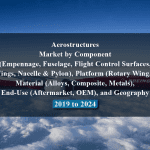OVERVIEW
Aviation’s Augmented and Virtual Reality Market is projected to reach USD 1,372.34 million by 2025, rising at a CAGR of 61.45 per cent during the 2020-2025 forecast period. The increased efficiency and cost savings are major factors that drive growth in aviation in the augmented and virtual reality industries. Better customer experience and decreased chances of human mistake often lead to the growth of the market.








TABLE OF CONTENT
1 Global Augmented and Virtual Reality (AR VR) Market
1.1 Study Objectives
1.2 Market Definition
1.3 Study Scope
1.3.1 Markets Covered
1.3.2 Geographic Scope
2 RESEARCH METHODOLOGY
2.1 Research Data
2.1.1 Secondary Data
2.1.1.1 Key Data From Secondary Sources
2.1.2 Primary Data
2.1.2.1 Key Data From Primary Sources
2.1.2.2 Key Industry Insights
2.1.2.3 Breakdown of Primaries
2.2 Market Size Estimation
2.2.1 Bottom-Up Approach
2.2.2 Top-Down Approach
2.3 Market Breakdown and Data Triangulation
2.4 Research Assumptions
3 Global Augmented and Virtual Reality (AR VR) Market – Executive Summary
3.1 Market Revenue, Market Size and Key Trends by Company
3.2 Key Trends by type of Application
3.3 Key Trends segmented by Geography
4 Global Augmented and Virtual Reality (AR VR) Market – Comparative Analysis
4.1 Product Benchmarking – Top 10 companies
4.2 Top 5 Financials Analysis
4.3 Market Value split by Top 10 companies
4.4 Patent Analysis – Top 10 companies
4.5 Pricing Analysis
5 Global Augmented and Virtual Reality (AR VR) Market – Industry Market Entry Scenario
5.1 Regulatory Framework Overview
5.2 New Business and Ease of Doing business index
5.3 Case studies of successful ventures
5.4 Customer Analysis – Top 10 companies
6 Global Augmented and Virtual Reality (AR VR) Market – Market Forces
6.1 Introduction
6.2 Market Dynamics
6.2.1 Drivers
6.2.2 Opportunities
6.2.3 Challenges
6.3 Porters Analysis of Market
6.3.1 Bargaining power of suppliers
6.3.2 Bargaining powers of customers
6.3.3 Threat of new entrants
6.3.4 Rivalry among existing players
6.3.5 Threat of substitutes
7 Global Augmented and Virtual Reality (AR VR) Market – Strategic Analysis
7.1 Value Chain analysis
7.2 Product Life Cycle
7.3 Supplier and distributor analysis (Market share and product dealing strategies)
8 Global Augmented and Virtual Reality (AR VR) Market – By Type (Market Size – &
million/billion)
8.1 Augmented Reality
8.2 Virtual Reality
9 Global Augmented and Virtual Reality (AR VR) Market – By Function
9.1 Training
9.2 Pilots
9.3 Crew & Ground Support Staff
9.4 Airlines
9.5 MRO
9.6 Engineers
9.7 Operations
9.8 Others
10 Global Augmented and Virtual Reality (AR VR) Market – By Components
10.1 Hardware
10.2 Sensors
10.3 Processors & Controllers
10.4 Display
10.5 Cameras
10.6 Others
11 Global Augmented and Virtual Reality (AR VR) Market – By Application
11.1 On-board
11.2 In-flight Entertainment (IFE)
11.3 Flight Deck Systems
11.4 Off-board
12 Global Augmented and Virtual Reality (AR VR) Market – By Vertical
12.1 Civil
12.2 Military
13 Global Augmented and Virtual Reality (AR VR) Market – By Geography (Market Size – &
million/billion)
13.1 Introduction
13.2 North America
13.2.1 US
13.2.2 Canada
13.2.3 Mexico
13.3 Europe
13.3.1 U.K
13.3.2 Germany
13.3.3 Italy
13.3.4 France
13.3.5 Spain
13.3.6 Rest of Europe
13.4 Asia-Pacific
13.4.1 China
13.4.2 Japan
13.4.3 India
13.4.4 South Korea
13.4.5 Rest of APAC
13.5 Rest of the World
13.5.1 South America
13.5.2 Middle East
13.5.3 Africa
14 Global Augmented and Virtual Reality (AR VR) Market – Entropy
14.1 New product launches
14.2 M&A’s, collaborations, JVs and partnerships
15 Global Augmented and Virtual Reality (AR VR) Market Company Profile (Key Players)
15.1 Market Share, Company Revenue, Products, M&A, Developments
15.2 Microsoft Corporation
15.3 Google Inc.
15.4 Bohemia Interactive Simulations
15.5 Oculus VR
15.6 Skylights Aero
15.7 Eon Reality
15.8 Aero Glass
15.9 Sita
15.10 HTC
15.11 Upskill
15.12 Company 11 & more
16 Global Augmented and Virtual Reality (AR VR) Market – Appendix
16.1 Sources
16.2 Abbreviations













